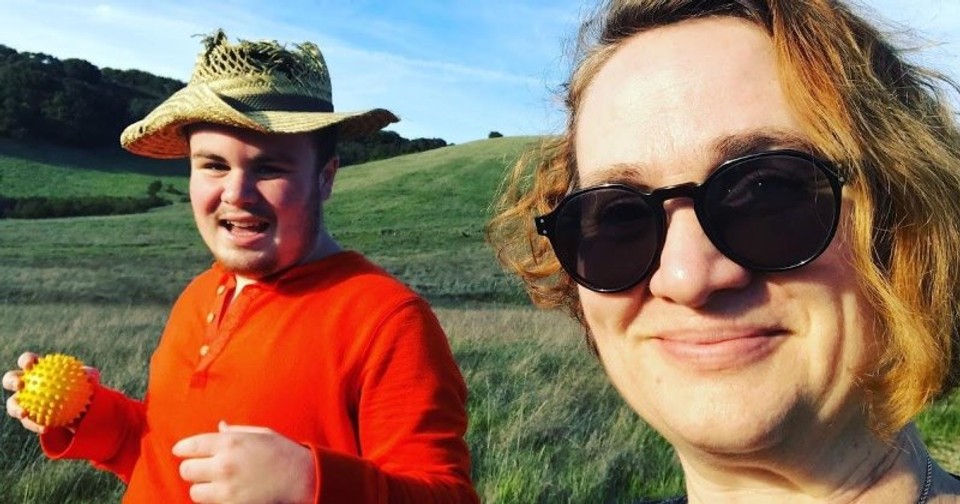Shannon Des Roches Rosa has been writing about autism and parenting since 2003. She’s the co-founder of Thinking Person’s Guide to Autism and the editor of the book by the same name. At The Kelsey, we were lucky to meet Shannon and her son Leo through our Together We Can Do More Initiative. Her insights on inclusion and autonomy, her vision for Leo’s future, and her understanding of housing needs were so valuable for our process. We’re excited to explore these topics more with Shannon, and share them with you!
When you envision the ideal housing for Leo, what do you see?
Well, ideally it would be the housing scenario Leo wants, whether that is to continue to live with us, or to live in an inclusive community like The Kelsey is creating. The most important element for me, since Leo will likely continue to require 1:1 support regardless of where he lives, is that anyone who is on Leo’s support and/or housing team respects his autonomy and rights, because he has *opinions*. He should be able to steer his own schedule and his own space.
I don’t mean to be a downer, but too often people with my son’s level of support needs find that their housing scenarios and schedules are driven by the needs and convenience of staff, and that is not cool.
Sometimes people say, especially in the context of neurodiversity, that inclusion is only possible for certain levels of needs/functioning and not others. Do you believe inclusion is possible for all levels of ability?
Neurodiversity is by its very nature inclusive, as the neurodiversity movement has always included every one of all abilities—people with intensive support needs were neurodiversity movement founders, and continue to be leaders even now. I think people who are new to disability, don’t know disability history, or who come from outside the disability community get confused by what the neurodiversity movement has accomplished because those people have been socially conditioned to believe that people with high support needs can’t have the rights and autonomy neurodiversity advocates have fought for and guaranteed. So they assume that neurodiversity advocates don’t or couldn’t possibly include people like Leo. Ironically, the people who criticize neurodiversity tend to be the ones who want people with higher support needs to have segregated housing and spaces.
How do you think housing and services intersect? Where should they overlap, and where do they need to stand alone?
It can be risky to have too much overlap in housing and services, because the fewer outside connections people with disabilities have in their living spaces, the less likely any problems they encounter will be addressed—and the more likely they are to be abused or neglected. Sorry to be a bummer, but this is why self-advocates in our community fight so hard against institutions and other forms of segregated housing.
There is safety in visibility, so regardless of how any housing and services scenarios overlap, there should also be some form of outside quality assurance and supervision.
In the disability services and housing world, independence and inclusion are often discussed as theories and principles, but what do they look like in practice?
I think independence and autonomy get conflated, and that leads to confusion and delay. Anyone can self-advocate, meaning specifically that anyone can learn to stand up for their own rights, however, they communicate. And when you can self-advocate, and your self-advocacy is taken seriously and respected, then you have autonomy. Does this mean you are independent? Not necessarily. But independence is not the goal. Autonomy is.
In practice, this looks like the “burrito rule,” that you can have a microwaved burrito at any hour of the day or night if you want one, just like any other adult. This looks like people not forcing you to go on group outings if you don’t want to. This looks like not being given sleeping meds so you will stick to a sleeping schedule for support staff’s convenience, even if you want to stay up all night watching Teen Titans Go.
As for inclusion, that means you are part of your community, however you choose to be. It means people in your community know who you are, and would notice if something was different about you. This goes back to the safety issue and is also about normalizing disability. Human nature is to be cool with the familiar and shy away from the unfamiliar. Inclusion is, in part, about ensuring people with disabilities are as familiar as anyone else in the community.
Thank you, Shannon, for your thoughtful insights. We are so grateful to have worked with you in our workshop process. To learn more about the people and ideas from our Together We Can Do More Initiative, click here to watch the film and download the report.
